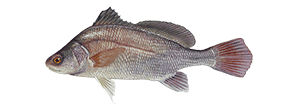Freshwater Drum

Species Details
Aplodinotus Grunniens
Sciaenidae
Perciformes
Lake, River
5 - 54 lbs.
12" - 37"
Freshwater Drum (Aplodinotus grunniens) Fish Description
The Freshwater Drum (Aplodinotus grunniens), as the name implies, is a popular gamefish native in the freshwaters of North America. From its scientific name, aplodonius is a Greek word that means “single back”; while the word grunniens is Latin which means “grunting” referring to the grunting or rumbling noise the males make during breeding season. Also, because of the noise they make, it’s been called different names, including: croaker, thunder pumper, grunter, grinder, and bubbler.
The fish can easily be identified through its silver scales with bluish-grey overcast. Its deep body is laterally compressed and has a prominent lateral line that runs across the entire length of its body. Other distinguishing features this fish has include: a blunt nose, a long and spiny dorsal fin that’s divided into two, a small horizontal mouth located at the bottom of its head, a prominently arched top, and a white belly.
The Freshwater Drum is also a carnivore and eats a variety of smaller aquatic animals, including: fish, crayfish, and insects. Snails and small clams, however, are their main fare. Aside from humans, their predators are usually larger fishes such as such as the smallmouth bass and walleye. This is the reason why some anglers use Freshwater Drums as baits for other bigger fishes.
During spawning season, which occurs in April or May, the females and males release their eggs and sperm into the open water and gets fertilized randomly. The fertilized eggs would then be carried pretty much anywhere, thus, explaining the far and wide distribution of the fish species across the country.
Interesting Facts About Freshwater Drums
- The biggest Freshwater Drum caught on record measures more than two feet and weighs approximately fifty-four pounds.
- The world record catch was done way back in 1972 by angler Benny Hull in Nijack Lake, Tennessee.
- Females are generally much bigger than males.
- The male of the species produce grunting sound during breeding season.
- Mature males make the grunting noise by contracting muscles along their air bladder walls.
- The purpose of the grunting noise they make is actually not known, though it’s linked to spawning.
- Eggs can be swept for miles and miles by the current, carrying them to different rivers, lakes, and other waterways, until they eventually hatch.
- They have this rather large, ivory-like ear bone that’s sometimes called “Lucky Stone.”
- The “Lucky Stones” are strung together and worn by Native Americans as a necklace or bracelet.
- The fish has big molar-like teeth that they use to crush snails, clams, and other mollusks.
- They spend most of their life at or near the bottom as they continuously look for food.
- They are one of the most abundant freshwater fish in the country.
Freshwater Drum Average Speed and Size
The Freshwater drum sizes average about ten to fourteen inches in length and weighs one to eight pounds when it matures. And although this fish can be a fairly quick swimmer, it really doesn’t matter because it’s one of the easiest freshwater fish you can catch. In fact, some anglers have recorded more than fifty catches in one sitting.
Where to Find Them - Habitat and Distribution
As mentioned above, Freshwater Drums are everywhere and can pretty much be found en masse in every lakes and rivers across the country. And even though summer is when Drum populations are in their peak, you can still catch more than a few of these fish come winter time.
It’s also important to know that Freshwater Drums are known bottom feeders, meaning they spend most of their time swimming at the bottom to look for food. They also prefer clear shallow waters with a little bit of aquatic vegetation.
Freshwater Drum Fishing Tips
Because Freshwater Drums aren’t really that hard to catch—not to mention they are not known to really put up a fight once hooked, a basic 6 1/2- to 7 1/2-foot medium- or medium-heavy-power spinning or casting rod and a medium-capacity spinning or baitcasting reel combo is all that is required in catching this fish. A 10- to 20-pound-test mono line would also be enough. Lastly, natural baits such crayfish tails, night crawlers, and cutbait are known to be more effective in luring this fish grab a-hold of your bait.






